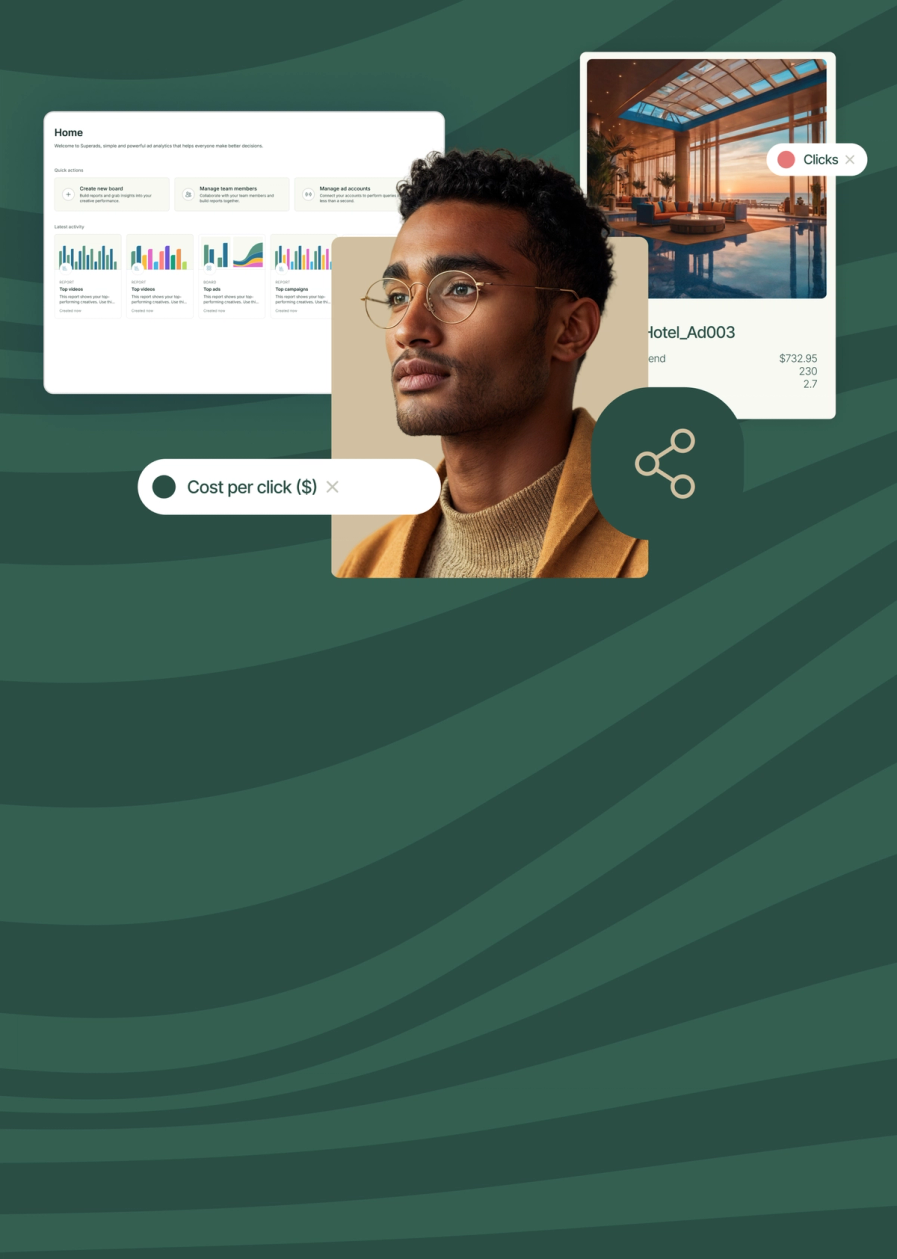
Creative performance benchmarking and measurement are essential for improving campaign performance—helping you compare your performance internally or against competitors and using clear, data-driven standards. In addition to recapping the essentials of benchmarks, you'll also get expert insights into why all benchmarks are not created equal.
There's increasing pressure on marketing and creative teams to produce high-performing creative that grabs attention and drives results.
Measuring results is a key piece of the performance creative puzzle. On their own, individual metrics are just standalone flashes of light. Creating systems and processes that give context and add meaning to the metrics gives everyone a better perspective on the big picture.
This is where benchmarking comes into play. It gives you relevant reference points for interpreting creative analytics data and using these insights to consistently achieve better outcomes on platforms like Facebook, Instagram, and TikTok.
Keen to put your standards to the test? Let’s take a deep dive into the power of creative performance benchmarking and measurement.
What Are Benchmarks?
Benchmarking is the process of setting standards to help you identify performance gaps. It's a point of reference that compares performance metrics against industry standards, competitors or your brand’s past performance to weigh success and contextualize your data.
Setting measurable standards to assess how well a creative asset or campaign performs relative to expectations lies at the heart of the process.
It’s best to benchmark against:
- Competitors: Comparing your performance to competitors using Python web scraping helps you understand industry norms and customer expectations. This will help you adjust your creative to stay competitive and relevant.
- Past performance: Looking at your previous results helps you understand your progress and identify areas needing improvement. If your results look good, you can keep doing what you’re doing (and do more of it). If not, it’s time to figure out why.
- Goals: Creating benchmarks based on goals lets you see whether your outcomes align with your initial expectations. If you’re not meeting expectations, it might be time to adjust your goals to remain realistic.
3 Main Types of Creative Performance Benchmarks
Typically, there are three types of benchmarking used to measure creative performance: industry, internal and competitive benchmarks.
1. Industry benchmarks
This type helps you see how your creative compares to others in your sector. In other words, you can see whether your campaigns and key performance indicators (KPIs) are doing well to competitor campaigns and KPIs.
- Metrics to monitor include click-through rates, conversion rates, engagement levels and return on investment (but there are many more).
- Benefits include identifying areas for improvement and recognizing trends that can help you improve your creative strategies.
2. Internal benchmarks
These insights focus on tracking your creative performance over time. Comparing your current campaigns to previous ones can help you see progress and identify patterns in your performance.
- Metrics to monitor include year-over-year (YOY) growth in engagement rates, changes in conversion rates across different campaigns, and average production times for creative projects (once again, there are many other metrics you can track).
- Benefits include insights into what works well and, as a result, ideas for continuous improvement. It can also help you set realistic goals based on historical data.
3. Competitive benchmarks
It helps you compare your creative strategies to your direct competitors’ strategies. With competitors, you can do:
- Strategic benchmarking (comparing business models and strategies).
- Process benchmarking (comparing business and operational processes).
- Performance benchmarking (comparing business outcomes based on a set of metrics).
Understanding competitors' insights helps you identify strengths and weaknesses and adjust your strategies to gain a more competitive edge.
- Metrics to monitor include market share, website traffic, engagement rates and brand sentiment.
- Benefits include gaining a precise understanding of your market position. This insight can drive innovation, spark creative strategies that elevate your performance and differentiate you from competitors.
The Importance of Setting Benchmarks To Measure Creative Performance
Creative analytics typically involves in-depth analysis and optimization of creative elements like visuals, copy or design.
Setting clear benchmarks and goals for measuring ad performance brings better focus to identifying clear patterns and ensuring continual improvement.
Helping you more effectively:
Improve and inform data-backed decisions
Creative performance benchmarking and measurement help you set clear operational standards, rely on data instead of subjective opinions and focus on changing creative elements that will make the most significant difference.
Defining relevant indicators also helps you:
- Define what success looks like: For instance, if you aim for a steady 10% increase in lead generation and are on track to achieve 11%, you can confidently say you’ve exceeded your goals.
- Identify winning ideas and performance gaps: Historical data from past campaigns gives you a reference for current campaigns. When one proven format exceeds past conversion rates, you know there's something working well. If there's a dip, you need to figure out what isn't working.
- Improve the quality of your creative: If your goal is to achieve higher ad CTRs, benchmarking helps you try new design elements such as images, illustrations, copy and CTA testing.
By tracking what resonates with your audience and comparing it to industry standards, you can adjust your designs for better engagement. Over time, this leads to more impactful creative that captures attention and drives performance.
Expert Advice: All Benchmarks Are Not Created Equal
Your chosen metrics should directly reflect your marketing objectives, whether they’re building brand awareness, driving engagement or generating leads. The right metrics provide insights that are directly actionable, letting you make informed decisions that optimize your strategy.

Focusing on the metrics that matter helps you allocate your time, budget and efforts more efficiently. Tracking these metrics gives you a better view of campaign performance, improving short-term results and driving long-term growth. Both of these statements are logical and valid.
However, there's another very crucial factor at play with creative performance benchmarks and creative analytics in general: context.
Enter the ever-present role of context
When you slice performance, you've got to do it in a lot of different ways. Something that could be considered a blanket loss in one category may be a huge win in another.

Every marketing channel has its own distinct characteristics and nuances, funnel stage and even the questions you're trying to answer all affect the metrics you choose and even how you interpret them.
In a recent creative performance webinar, Sprout Social's Kelsey Gregorc shared how she and her team approached the testing and refreshing of their always-on ads.
Before simply picking metrics and experimenting with ad variations, the team took the time to think about the questions they wanted to ask and the things they wanted to learn. In turn, this determined which variables they measured, the benchmarks they set and how the results were interpreted.
For instance, the data showed that a more conceptual concept nearly doubled LinkedIn conversions. However, the conceptual concept had little to no impact on display ad performance.
Because the conceptual layouts took longer to design, they made sense for LinkedIn, but wouldn't for display. If you were having to make a blanket decision either way, to use conceptual layouts or not, without considering the context, the choices would be much less clear.
5 Steps To Creating Effective Creative Performance Benchmarks
Reliable, evergreen indicators set you on the path to ad optimization success. Here are five steps for setting effective creative analytics benchmarks:
Step 1: Identify what to benchmark
Strategic benchmarking should focus on a specific part of your marketing efforts. Instead of measuring overall campaign performance broadly, you might compare the CTR of your social media ads. For enterprise businesses, strategic benchmarking often focuses on specific areas, such as the performance of ads in different geographies, audience segments or product categories.
Clearly defining what you’re comparing—whether engagement or conversion rates—ensures you're aligned with larger business goals. If you sense certain areas of your campaigns aren’t performing well, the data will help you validate these assumptions.
Step 2: Check your past performance metrics
Next, collect data from your previous campaigns. For social media ads, this might include how many people interacted with your ads, how many times your ads were seen, video watch times, landing page retention rates and how much money you spent on your ads.
These numbers should be segmented by region, target customer persona, or product category so you can evaluate what’s worked best in different contexts.
Step 3: Collect competitor and industry data
Now, find industry numbers to compare. If you’re comparing your social media ads, use competitive benchmarking tools like Semrush, Sprout Social or Moz to see how your engagement compares to other brands.
Market research or industry reports can also help you set relevant indicators. Identify the key metrics that matter most for your business goals at this stage.
For an enterprise with a global presence, you might also consider looking at industry reports and market research from providers like Gartner or Forrester to understand your relative position within your sector.
Enterprise-level marketing teams also need to segment their competitor analysis by product vertical and market regions. For example, SaaS companies in the U.S. might face different competitive dynamics compared to those in Europe or Asia. Understanding these regional differences helps set more accurate benchmarks.
Common performance metrics include CTR, engagement rate, cost-per-click (CPC) and cost per customer acquisition (CAC). It’s important to choose metrics that align with your objectives, such as brand awareness, lead generation or sales.
Step 4: Measure current campaign performance
Using tools, like Superads, helps quickly build and share visual reports that answer critical questions about the ads you’re running on Meta, LinkedIn and TikTok.
Analyzing this data will help you spot trends and determine which creative elements perform well. It'll also show you how different types of creative affect user engagement and conversion, so you can learn and iterate in real time.
Traditionally, capturing this information has been harder than it should be. Many teams start by gathering data from the native platform tools, porting it over to spreadsheets and skimming for meaning across mind-numbing columns and rows of data. Not to mention the subsequent challenge of sharing this information cross-functionally across teams, departments and even throughout the company.
There has to be a better way!
This is one of the reasons Superside developed Superads. As a creative service provider, our leaders saw that this was something we and our customers struggled with. Recognizing it was time for analytics tools to join us in the digital era, we've created a tool that captures platform-specific data, alongside the standard and custom metrics you choose to set.
The information is presented in intuitive, drag-and-drop interfaces that let you visualize the metrics in the ways that make the most sense to you. Superads also leverages AI to further power analysis and uncover insights. And, sharable links make cross-collaboration as quick as copying and pasting the link.
✨Try Superads for free!
Step 5: Apply and track changes
If the data shows high engagement with how-to videos, you should consider creating more tutorial-based content that matches your audience’s interests.

The fifth step is creating and applying strategies that close creative performance gaps. Two ways you can do this include:
- Creative briefs: Let the data you collect help shape your creative briefs. Look at performance aspects, like preferred formats or color palettes, that you’ve identified through research.
- Continuous testing: Use A/B testing to compare creative variations with your findings. You can improve your creative assets based on the test results you get to boost your performance metrics.
Use the data to not just adjust current campaigns but also to set up long-term creative strategies that take into account shifting customer behaviors and market dynamics. Enterprise marketing teams should use creative testing to compare variations across regions, audience segments and marketing channels to identify scalable patterns.
Shopify: An example of non-stop testing, measurement and refinement
Take Shopify for example. As Shopify expanded its reach across 175 countries, its challenge was creating and testing multiple creative assets while maintaining brand consistency. By partnering with Superside, they scaled production, tested various creatives, and rapidly iterated, boosting campaign performance and uncovering new growth opportunities. This resulted in 4,375 assets delivered in 24 hours and 100% global social media coverage.
Effective creative performance benchmarking and measurement is an ongoing process. Continuous data collection is critical to staying on top and ahead of trends.
Common Creative Performance Benchmarking Mistakes
Sometimes, it's the simple (or not-so-simple) things that make all the difference.
Raise the Bar on Creative Performance
By using insights to refine strategy, you create a feedback loop that continuously elevates your creative, ensuring it not only reaches but truly resonates with your audiences and moves the needle for your brand.

Regardless of your industry and the rate of market changes, creative performance benchmarking and measurement drives stronger, data-backed decision-making, better resource allocation and more successful ad campaigns.
When scaling omnichannel digital campaigns, as many enterprise marketing and creative teams often are, turning creative analytics into actionable insights directly contributes to overall efficiency and effectiveness.
Knowing what works, means everyone is on the same page from brainstorming and briefing to execution and measurement and back again.
But what about combining this ability with added capacity, bandwidth and industry expertise? If you need a trusted partner that melds ad performance data with industry-leading creativity, Superside helps you not only do this well, but also at scale. Schedule a commitment-free intro call to learn more.




















